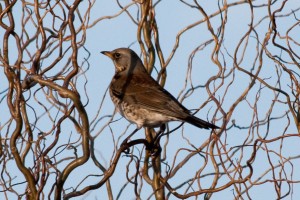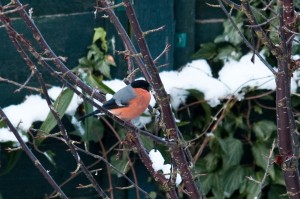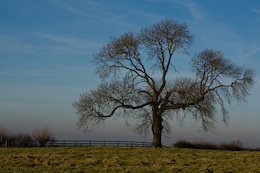Many people may have noticed some unusual visitors to their garden during the recent cold snap. They look like thrushes, but there is something a bit different about them. Those of us not fortunate enough to have these birds in their garden may however have noticed flocks of light coloured birds flying over head, or hopping about in the fields. Or, if disturbed on a walk round the country park, flying up out of the hedgerows making a loud chacking alarm call.
Did you see a large thrush (about the same size as a mistle thrush), but with a grey head, and chestnut back, perhaps it flew off and looked very pale underneath, or a flock of pale looking birds flew over you? These are fieldfares, visitors from Scandinavia, three quarters of a million of which arrive around the end of October (braving the north sea and the waiting, hungry gulls), slowly spreading south and west, making the return journey in March and April. Their arrival has been seen as a sign of winter for centuries, dating back to Chaucer’s day when they were trapped and eaten for food, apparently they are as tasty as quail (which I have also never eaten).
Unlike most thrushes, these are very gregarious, they arrive in flocks, leave in flocks, wander around the countryside in flocks and even nest in groups back in Norway. When was the last time you saw a flock of song thrushes (or more than a couple together for that matter)?
Normally fieldfares would feast on invertebrates and are usually seen in groups ‘head up, chest out, all facing the same direction and spread evenly across a snow-dusted field’. However, once the ground freezes they move into the hedgerows to eat berries, particularly hawthorn, and will also take advantage of windfall apples and cotoneaster berries in larger gardens.
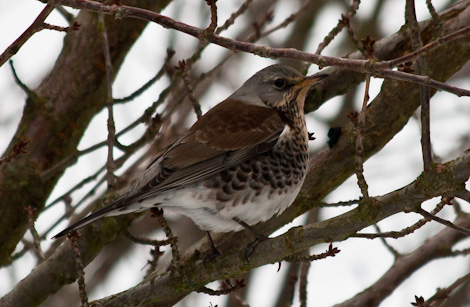
The other member of the thrush family that visits in winter is the very pretty redwing. These arrive about a month before the fieldfares and are usually heard before they are seen, thousands arriving at the east coast overnight, making ‘seeping’ noises (not sure what that sounds like!) as they travel further west in their flocks. Hundreds of thousands of them arrive each winter, but these are less robust than the fieldfares and other thrushes and a particularly harsh winter could result in the majority perishing. They also leave to venture back to Scandinavia around April.
These little thrushes are very similar to the song thrush, but they have a cream stripe above their eye which makes them unmistakeable, even at a distance. The red patch under their wing is just visible when perched, but contrasts with their creamy underparts and becomes much more visible in flight.
These are much shier than the fieldfares, and, although they feed on the same invertebrates and berries they are more likely to be found in hedgerows than in the open fields. As soon as they are disturbed they will fly off into higher trees, making their alarm calls (hence my incredibly poor picture being the best I have managed to date). I think that they tend to come into gardens more often than fieldfares (although neither have appeared in mine), being particularly fond of cotoneaster berries.
These little thrushes are also apparently quite tasty, years ago they were particularly prized in France where they arrived in time to fatten themselves up on the ripe grapes.
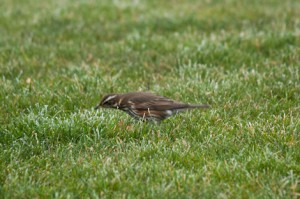
So keep your eyes open for these winter visitors, there are lots around Daventry, and they are likely to be here into March, depending on the weather.
